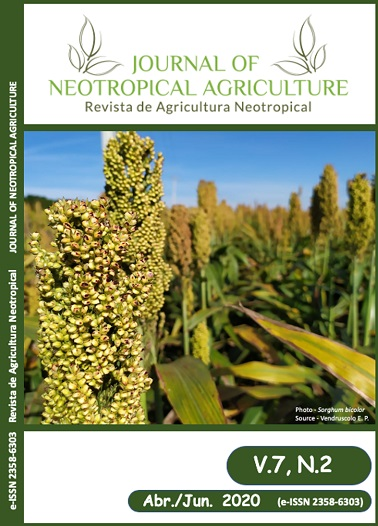INFLUENCE OF COVERAGE BASED ON BIOPOLYMERS ON THE MATURATION OF CAGAITA (Eugenia dysenterica DC.)
DOI:
https://doi.org/10.32404/rean.v7i2.3334Abstract
The cagaita is a native fruit of the cerrado, of high perishability, and for postharvest conservation of the fresh fruit, methods are used to increase its life cycle. In the present study, edible coatings are used, a technique that aims to control the loss of mass through transpiration reduces gas exchange, increases the shelf-life, improves the appearance, preserves the structural integrity and mechanical properties. The study aims to evaluate the influence of coatings based on biopolymers on the maturation of cagaita during storage. The factorial scheme 3 x 4 was used, with three treatments - without coating, polysaccharide coating and protein coating, four evaluation points - with an interval of 2 days, stored at 25 ºC. The fruits were submitted to weight loss, pH, titratable acidity, soluble solids, and ascorbic acid evaluations. There was no influence of the time factor in the present study, and for titratable acidity, ascorbic acid, soluble solids, and pH, there was no significant difference between treatments. Observing the content of soluble solids, the main indicator of ripeness, which varies from 5 to 7 ºBrix, it was concluded that the fruits did not ripen.References
(I) Almeida Júnior, E.B.D., Chaves, L.J., Soares, T.N., 2014. Genetic characterization of a germplasm collection of cagaiteira, a native species of the cerrado. Bragantia, 73(3), 246-252.
(II) AOAC. Association Official Analytical Chemistis, 2010. Official Methods of Analysis of AOAC International, 18th ed. AOAC International, Gaithersburg.
(III) Belibi, P.C., Daou, T.J., Ndjaka, J.M.B., Michelin, L., Brendlé, J., Nsom, B., Durand, B., 2013. Tensile and water barrier properties of cassava starch composite films reinforced by synthetic zeolite and beidellite. Journal of Food Engineering, 115(3), 339-346.
(IV) Bessa, R.A., Oliveira, L.H., Arraes, D.D., Batista, E.S., Nogueira, D.H., Silva, M.S., Ramos P.H., Loiola, A.R., 2015. Filmes de amido e de amido/zeólita aplicados no recobrimento e conservação de goiaba (Psidium guajava). Revista Virtual de Química, 7(6), 2190-2201.
(V) Botrel, D.A., Soares, N.F.F., Camilloto, G.P., Fernandes, R.V.B., 2010. Revestimento ativo de amido na conservação pós-colheita de pera Williams minimamente processada. Ciência Rural, 40(8), 1814-1820.
(VI) Camilo, Y.M.V., Souza, E.R.B., Vera, R., Naves, R.V., 2014. Caracterização de frutos e seleção de progênies de cagaiteiras (Eugenia dysenterica DC.). Científica, 42(1), 1-10.
(VII) Cardoso, L.M., Martino, H.S.D., Moreira, A.V.B., Ribeiro, S.M.R., Pinheiro-Sant’Ana, H.M., 2011. Cagaita (Eugenia dysenterica DC.) of the Cerrado of Minas Gerais, Brazil: physical and Chemical characterization, carotenoids and vitamins. Food Research International, 44(7), 2151-2154.
(VIII) Chitarra, M.I.F., Chitarra, A.B., 1990. Pós-colheita de frutos e hortaliças: fisiologia e manuseio. ESAL/FAEPE, Lavras.
(IX) Chitarra, M.I.F., Chitarra, A.B., 2005. Pós-colheita de frutas e hortaliças: fisiologia e manuseio, segunda ed. UFLA, Lavras.
(X) Falguera, V., Quintero, J.P, Jiménez, A., Muñoz, J.A, Ibarz, A., 2011. Filmes e revestimentos comestíveis: Estruturas, funções ativas e tendências em seu uso. Tendências em Ciência e Tecnologia de Alimentos, 22(6), 292-303.
(XI) França, D.L.B., Braga, G.C., Laureth, J.C.U., Dranski, J.A.L., Moura, C.A., 2018. Physiological response, antioxidant enzyme activities and conservation of banana treated with ethanol vapor. Journal of Food Science and Technology, 56(1), 208-216.
(XII) R Core Team, 2017. R: A language and environment for statistical computing. R Foundation for Statistical Computing, Vienna, Austria. http://www.R-project.org/ (acessado 16 de dezembro de 2018).
(XIII) Santos, P.R.G., Cardoso, L.D.M., Bedetti, S.D.F., Hamacek, F.R., Moreira, A.V.B., Martino, H.S.D., Pinheiro-Sant'Ana, H.M., 2012. Cagaita (Eugenia dysenterica DC.) jelly: development, microbiological, sensory, chemical characterization, and stability study. Revista do Instituto Adolfo Lutz (Impresso), 71(2), 281-290.
(XIV) Silva, M.M.M., Silva, E.P., Silva, F.A., Ogando, F.I.B., Aguiar, C.L., Damiani, C., 2017. Physiological development of cagaita (Eugenia dysenterica). Food Chemistry, 217, 74-80.
(XV) Silva, M.R., Santos Júnior, R.T.O., Ferreira, C.C.C., 2008. Estabilidade da vitamina C em cagaita in natura e durante a estocagem da polpa e refresco. Pesquisa Agropecuária Tropical, 38(1), 53-58.
(XVI) Silva, S., Tassara, H., 2003. Frutas no Brasil, quinta ed. Editare, São Paulo.
(XVII) Souza, A.C., Benze, R.F.E.S., Ferrão, E.S., Ditchfield, C., Coelho, A.C.V., Tadini, C.C., 2012. Cassava starch biodegradable films: Influence of glycerol and clay nanoparticles content on tensile and barrier properties and glass transition temperature. LWT - Food Science and Technology, 46(1), 110-117.
(XVIII) Strohecker, R.L., Henning, H.M., 1967. Analisis de vitaminas: métodos comprobados. Madrid: Paz Montalvo.
(XIX) Terán-Ortiz, G.P., Silva, M.G., Lima, H.C., Paciulli, S.O.D., Silva, V.A., 2013. Avaliação pós colheita de cagaita (Eugenia Dysenterica). Magistra, 25, 1-6.
Downloads
Published
How to Cite
Issue
Section
License
The authors retain the rights to the manuscripts and, therefore, are free to share, copy, distribute, perform and publicly communicate the work under the following conditions:
Acknowledge work credits in the manner specified by the author or licensor (but not in a way that suggests that you have their support or that they support their use of their work).
REVISTA DE AGRICULTURA NEOTROPICAL (ISSN 2358-6303) is under license https://creativecommons.org/licenses/by/4.0/
The State University of Mato Grosso do Sul, Sustainable Development Center of Bolsão Sul-Mato-grossense (CEDESU), of the University Unit of Cassilândia (UUC), preserves the patrimonial rights (copyright) of the published works and favors and allows their reuse under the license as mentioned above.
------------
The journal reserves the right to make normative, orthographic, and grammatical alterations in the originals, to maintain the cult standard of the language, respecting, however, the style of the authors.
Final proofs will be sent to the authors.
Published works become the property of the journal. The opinions expressed by the authors of the manuscripts are their sole responsibility.

